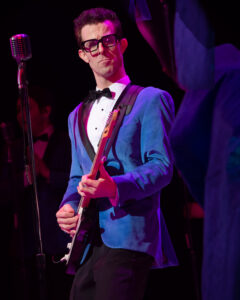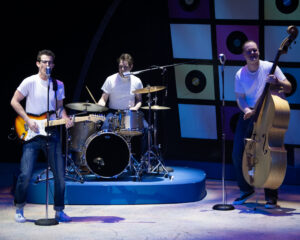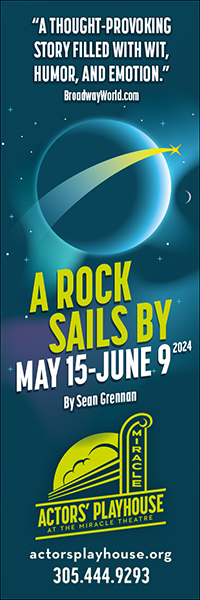
Matt McClure as Buddy Holly
By Britin Haller
The word of mouth is out about Buddy – The Buddy Holly Story (here on out to be referred to as just Buddy) at the Wick Theatre in Boca. The lobby was buzzing pre-show with excited patrons telling each other “So-and-so says it’s great!” and “I’ve heard it’s just spectacular!” And unless they didn’t realize Buddy has rock & roll in it, and they don’t like rock & roll, it’s a guarantee theatsrgoers left feeling satisfied, after dancing in their seats, and possibly even in the aisles.
There wouldn’t be a Buddy without Matt McClure, who not only stars as Buddy Holly, but wears this production’s director and scenic designer hats as well. Talk about a triple threat. With some notable detours along the way, McClure has pretty much spent the better part of his last decade traversing the country wearing Buddy’s thick horn-rimmed glasses, and one thinks the real Holly would be honored to see the love and commitment McClure gives to the role.
Interesting to note is what originally felt like McClure not portraying Buddy passionate enough especially given his career challenges and vocal expressions of love for his wife, later rang true to form when reading McClure’s director’s note in the playbill. “Buddy was clear in his intentions and open with his opinions, all while being as polite as can be; he wore his emotions on his sleeve, but rarely lost his cool.” So there you go, McClure’s downplaying, if you will, of Buddy is intentional. Nice choice.
Written by Alan Janes, and billed as the “World’s Most Successful Rock & Roll Musical” Buddy tells the story of the rocker’s rise to stardom, his meeting and marrying wife María Elena, and what really happened before “The Day the Music Died,” February 3, 1959, when his life was cut short in a tragic plane crash. In the style of a “jukebox” musical, the show feels more like a concert as audience members are encouraged, and in fact at times even lovingly chastised, for less than acceptable levels of participation.
Buddy Holly didn’t operate in a vacuum. His mom was his biggest fan, and she spent her days tracking him down by phone to remind the skinny kid to eat.
 In the beginning, his band was known as “Buddy Holly and the Crickets,” a group he put together comprised of fellow Texans, drummer Jerry Allison and bass player Joe B. Mauldin. Played by Chris Coffey and Kyle Lahr, the two musicians have some nice moments including one cute bit telling the story of the naming of the song “Peggy Sue,” and another involving synchronized waiting. Yes, waiting. Lahr is also wildly agile with his bass instrument and shows it off brilliantly. Benjamin Taylor Brown, who also plays bass in real life and has appeared as Mauldin at other times, takes the stage here as guitarist Nikki Sullivan, the fourth Cricket.
In the beginning, his band was known as “Buddy Holly and the Crickets,” a group he put together comprised of fellow Texans, drummer Jerry Allison and bass player Joe B. Mauldin. Played by Chris Coffey and Kyle Lahr, the two musicians have some nice moments including one cute bit telling the story of the naming of the song “Peggy Sue,” and another involving synchronized waiting. Yes, waiting. Lahr is also wildly agile with his bass instrument and shows it off brilliantly. Benjamin Taylor Brown, who also plays bass in real life and has appeared as Mauldin at other times, takes the stage here as guitarist Nikki Sullivan, the fourth Cricket.
Kent M. Lewis is Buddy’s buddy, Hipockets Duncan, a radio DJ who doesn’t understand why Buddy is so stubborn. All he has to do is play country music, but no, Buddy keeps on insisting on this rock and roll stuff. Lewis’s Texan accent sounded authentic, and his delivery is on point even while informing Buddy that “Rock and roll is a communicable disease.”
It’s always a great time when Wick crowd favorite Jawan E. Hayes is giving his all, and this time is no exception. Along with Vickie Joleen Anderson, the duo provides the evening’s biggest laughs as the emcees at Harlem’s Apollo Theater on the evening Buddy (dressed in an all-white suit) and the boys come to play their white rock & roll for an all-black audience. “We’re four honkies, we’re all gonna die,” one of the Crickets tells Buddy after they see where he’s booked them into. Attired in eye-catching gold-lamé-ish costumes, Hayes and Anderson perform the legendary The Isley Brothers song “Shout” with a rhythm and style to have you going “a little bit softer now, a little bit louder now” in your seat along with them.
Robert Brandon plays music publisher Murray Deutch, a genial fellow whose receptionist hiring skills are legendary given that he employs María Elena Santiago, aka the future Mrs. Buddy Holly. Not for long though because when Buddy spots her in Murray’s office, he requests Murray to give her the day off. “Buddy, she’s yours,” Murray tells him. As if Maria Elena doesn’t have a say in it. Then in an equally ick, albeit cute, moment, the remaining band members play rock paper scissors for Murray’s other office girl, Shirley.
As María Elena, the woman Buddy meets, dates, falls in love with, and proposes to in Central Park in the course of five hours, Allie Vazquez is the loyal wife Buddy needs. Her premonition that something bad will happen to Buddy on his upcoming tour results in him promising he won’t fly, a promise especially chilling given we know the way his short life ultimately ends. Vazquez is strongest when showing her love for her husband, and when he sings her the sweet and simple song he wrote for her, “True Love Ways,” we are touched.
Sarah Godwin is due a lot of credit as not only the musical director, but as Vi Petty, the wife of music manager Norman. “These boys look good,” Norman tells her when Buddy and his band first show up in their studio. “They don’t look that good,” she replies. Vi is a small role, but Godwin makes it a memorable one.
Mike Brennan is outstanding as both the snaky Norman Petty who has the audacity to tell Buddy to tithe ten percent to the church all the while withholding monies earned, and as singer J.P. Richardson, more well-known by his stage name “The Big Bopper.” The Bopper’s velour-ish, almost to the knees, leopard jacket almost stops the show during “Chantilly Lace,” and Brennan wears it well.
Giorgio Volpe brings Ritchie Valens to life, and Volpe’s enthusiasm projects off the stage. It’s a big night for Valens because he has a couple of “chicks” waiting for him after the plane ride at their next stop in Moorhead Minnesota. He’s a cute kid, and when we learn Ritchie is only 17, a collective “aww” is heard through the theater. Volpe’s big number “La Bamba” is met with the expected enthusiasm. What a shame Ritchie didn’t live long enough to see his song become an international sensation.
The last scene, and finale, are chock full of Buddy Holly classics everyone knows and loves. It’s Buddy’s final concert, only of course he doesn’t know it, and neither do his singer friends, Ritchie Valens and J.P. “The Big Bopper” Richardson who will later be perishing with him in a plane crash. Whomever came up with a zig-zagging tour across the Midwest in the middle of winter should have been fired because it’s ten degrees below zero outside, there’s a blizzard, the previous drummer had frostbite from frozen toes and had to be replaced, and the school buses they travel in have limited heat and keep breaking down. So, Buddy does the only sensible thing and books a private plane for himself and his band, however “The Big Bopper” and Ritchie Valens want those seats for themselves. In the worst coin flip ever, Ritchie wins a seat from Buddy’s guitarist, Tommy Allsup, and not mentioned, but a well-known fact, is that The Bopper got his from a then-unknown bass player from Texas named Waylon Jennings.
Natalie Hershman is making her Wick debut as the show’s choreographer and dance captain. Along with Jawan Hayes, Vickie Joleen Anderson, and Scottie Stampone, their roughly fifteen straight minutes of aggressive dancing near the show’s end shows their incredible stamina. And check out Hayes doing those jump splits. Musicians Randy Emerick on saxophone, and Miranda Simonne on trumpet, also appear energetically here.
The charismatic Justus Elliott stirs the crowd (us) as the emcee at the Surf Ballroom in Clear Lake, Iowa. His job is to get his audience excited for the upcoming “Winter Dance Party.” History buffs will be pleased to know the Surf is still in existence and on the National Register of Historic Places, there is a crash-site memorial in place featuring Buddy’s iconic horn-rimmed glasses, and streets around the Surf building are named for Holly, Richardson, and Valens. Road trip, anyone?
Stars behind the scenes include the stage manager Jeffry George who is fresh off his stint as director for the Wick’s last production, Carousel, his assistant stage manager Meg Rosenberg, the always consistent Clifford Spulock as lighting designer, and returning to the Wick after a national tour, Justin Thompson as sound design/engineer. Sets, costumes, and wigs are highly representative of the period. Dancers entertain during set changes with moves from the 1950s, so there is always something dynamic to look at.
So “Don’t forget to eat, and don’t forget to call your mother,” but mostly don’t forget to tell all your friends to join you at the Wick before the spectacular Buddy bops away for good.
Britin Haller is the Senior Editor for Charade Media. Her latest novel is Dumpster Dying by Michelle Bennington, available where books are sold. Find Britin across social media and at Charadebooks.com
Buddy-The Buddy Holly Story plays through May 5 at The Wick Theatre 7901 N. Federal Highway, Boca Raton FL; 7:30 p.m. Thurs-Sat; Matiness 2 p.m. Wed, Thurs, Sat & Sun. Running time approx. 140 minutes with a brief intermission. Tickets starting at $79. Call 561-995-2333, or visit thewick.org.







 A PaperStreet Web Design
A PaperStreet Web Design
